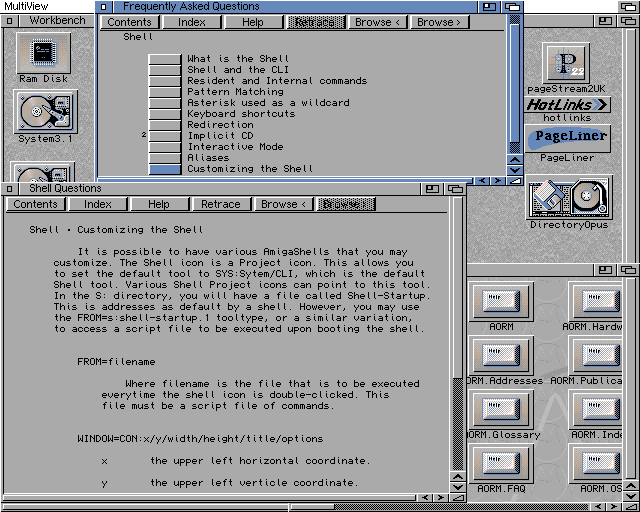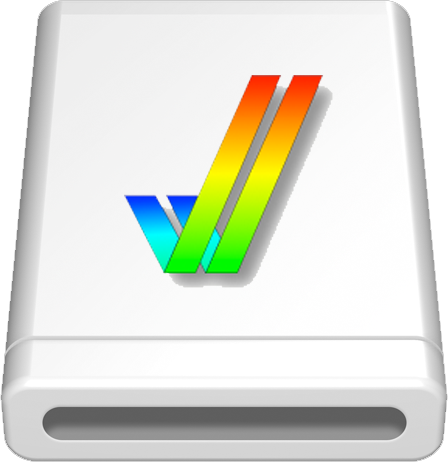CyberStorm 060 + Cybervision 64 (CU Amiga August 1995)
Cybervision 64
Moving on now, the other half of the combination deserves some space too. The CyberVision 64 is interesting in two respects. First off, it’s a 24 bit graphics card running on a Zorro III bus with 64 bit memory access on the card but secondly in that it tries to introduce a standard for Amiga retargetable graphics and 24 bit applications.
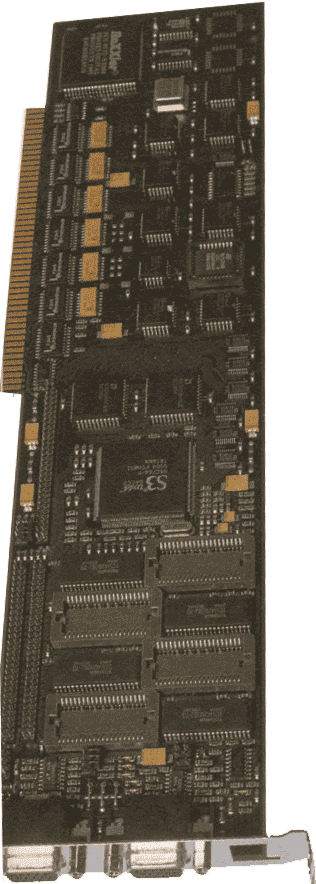 The board comes with either 2 or 4 MB of RAM and is based upon the S3 Trio 64 graphics chip as found in some PC graphics cards. A brief look at the board shows that it’s been well manufactured and that there’s plenty of connections for future upgrades. No modules have been announced for this yet, but multimedia expansions should be forthcoming soon.
The board comes with either 2 or 4 MB of RAM and is based upon the S3 Trio 64 graphics chip as found in some PC graphics cards. A brief look at the board shows that it’s been well manufactured and that there’s plenty of connections for future upgrades. No modules have been announced for this yet, but multimedia expansions should be forthcoming soon.
With the board safely installed in a Zorro III slot, all that is needed is to install the single disk of driver software. The software really does point towards a possible future of Amiga graphics in that it defines a standard for high resolution and high colour screens working on graphics cards that are not native to the Amiga hardware.
This software, called CyberGraphics, is very similar in design to the Picasso’s software (which is widely acknowledged as the best stab at integrating a VGA chip into an Amiga). It is now available for the majority of graphics cards on the market, including the Picasso, Piccolo, EGS Spectrum and PiccoloSD64. It consists of a set of libraries and a monitor file; the libraries work with all graphics cards and only the monitor file is board specific. It’s a small, efficient package. The distribution for other cards is soon to change – watch this space for more!
The Cybervision software is excellent. For workbench emulation it is stability itself and refuses to crash! Screen dragging (a feature which often disappears from graphics cards) is back again and the CyberGraphics software really excels in showing its cleverness in this department. With the CyberVision 64 and PiccoloSD64 in the test machine (both running CyberGraphics) it is possible to drag a screen that is being generated by one card down and reveal a screen behind it that is being generated by the other card! The level of integration and transparency in the system is astounding.
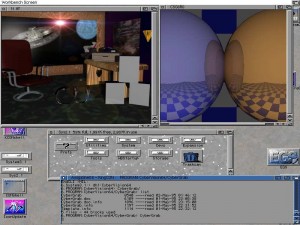 CyberGraphics defines a standard for 24 bit workbench applications, as EGS tries to. However, the CyberGraphics system integrates completely within the Amiga’s intuition system allowing for a 24 bit workbench screen to be opened. A screenshot shows this. There’s two 24 bit pictures on the screen, directories and a console window. The incredible thing is that the speed of the system is still amazing!
CyberGraphics defines a standard for 24 bit workbench applications, as EGS tries to. However, the CyberGraphics system integrates completely within the Amiga’s intuition system allowing for a 24 bit workbench screen to be opened. A screenshot shows this. There’s two 24 bit pictures on the screen, directories and a console window. The incredible thing is that the speed of the system is still amazing!
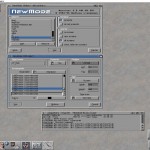 The CyberVision 64 comes with a utility called NewMode which forces any screen of a utility to another user defined screenmode. This is easy to use and works very well; much better than PicoRetarget as supplied with the PiccoloSD64.
The CyberVision 64 comes with a utility called NewMode which forces any screen of a utility to another user defined screenmode. This is easy to use and works very well; much better than PicoRetarget as supplied with the PiccoloSD64.
The other software provided with the card promises to be Photogenics Lite: this software has not yet been completed but it should allow for the 24 bit modes to be used as the primary photogenics screenmode. 24 bit painting and effects should be possible and if not too much is removed from Photogenics this should be a valuable addition to the CyberVision.
Benchmark-wise, this card beats the PiccoloSD64 in all respects of speed. Sometimes the difference is marginal but sometimes it’s absolutely massive even when the SD64 is running the CyberGraphics system instead of the EGS system that it comes with.
When both the CyberStorm and CyberVision are in the same machine, there’s a scarily fast beast instead of an Amiga on your desk. As an example, a test of drawing rectangles changed from a value of 12944 to 71476. In contrast, the PiccoloSD64 managed 9076 under the CyberGraphics software, 10058 under the original EGS software and refused to work point blank with the CyberStorm 060.
On the technical side of things, the card will chuck out pixels at an impressive rate: up to 1600×1200 pixels. The 2MB version will support 24 bit colour depths in up to 800×600 pixels – if you want more colours in higher resolutions you’ll need the 4MB. As with all graphics cards, a nice monitor is a necessity. For the CyberVision, you’ll need something capable of 31KHz horizontal frequency as a minimum but a 65KHz frequency would be much better.
There’s little to say about the graphics card other than it is scarily fast and that performance is very much better on a fast processor but will still knock the spots off AGA even without the CPU. The Cyberstorm really did incredible things to the playback of animations, too. On a 4000/030 running Scala MM300 a HAM8 lo-res animation used to glitch occassionally. With the CyberStorm, HAM8 hi-res interlace animations are possible – something Commodore said shouldn’t happen! This was a very nice demonstration of what the Amiga can do as it was a broadcast resolution animation (full overscan) running at 25 frames a second. I have no doubt at all that it would push fields through at 50 frames a second if necessary.
